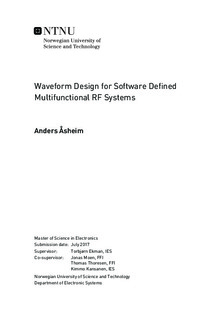Waveform Design for Software Defined Multifunctional RF Systems
Master thesis
Permanent lenke
http://hdl.handle.net/11250/2456898Utgivelsesdato
2017Metadata
Vis full innførselSamlinger
Sammendrag
In this thesis, a study of multifunctional radio frequency (RF) systems implementing radar, communication, and electronic warfare (EW) is presented. Development of low cost and highly adaptable software defined radios (SDRs) enables implementation of RF systems where waveforms are digitally synthesized. An SDR capable of simultaneously performing multiple RF functions (radar, communication, and EW), has the potential to replace multiple specialized systems. In such multifunctional systems, it is necessary to optimize the waveform for all RF functions. The impact waveform design optimization has on the different RF functions needs to be quantified.
Waveform design for common-off-the-shelf (COTS) SDRs are further analyzed in this thesis. Identifying degrees of freedom with respect to spread spectrum waveform design enables simultaneous multifunction. Performance requirements for the RF functions, and the effects of waveform design choices are formally analyzed. MATLAB tools to generate, analyze and simulate multifunctional waveforms have been implemented. This allows the design space to be analyzed and simulated. Linear frequency modulated (LFM), phase coded and pseudo-noise waveforms have been exploited to spread sequences of information symbols. Based on application areas, the generated waveforms have been investigated and simulated.
Key characteristics of different waveforms have been identified. LFM has high dynamic range. Results show significant reduction in dynamic range when used as a spreading sequence. Complex Gaussian noise has strong EW protection capabilities with a high instantaneous bandwidth. Using noise as a spreading sequence give promising simulation results. However, it requires high resolution in a real-world radar and communication receiver. Phase coded waveforms are proven effective for radar, communication, and EW. It has the same bandwidth as comparable Gaussian noise, but with a constant amplitude allowing simpler hardware.
In addition, a multifunctional radio frequency system (MRFS) prototype has been implemented and demonstrated on an SDR. An anti-drone scenario was chosen to demonstrate this prototype. A waveform was optimized to meet scenario specific parameters. The waveform was implemented based on results from simulation. Experimental results confirm that the phase coded waveform can simultaneously detect drones, synchronize communication, and jam a IEEE 802.11 Wi-Fi link. Experiments using a 1W radar implementation successfully detected the drone at 70m. At the same time, it was transmitting modulated symbols at a bit rate of 1.5 Mbps. 25MHz bandwidth gives a range resolution of 6m. The waveform was also capable of jamming the Wi-Fi link with a jamming-to-signal strength of 3 dB. This demonstrates the feasibility of simultaneous multifunction on COTS SDRs.
